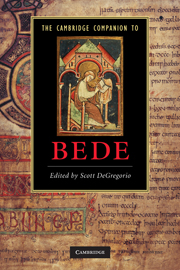Book contents
- Frontmatter
- Part I Bede’s Life and Context
- 1 Bede’s life in context
- 2 Secular and political contexts
- 3 The world of Latin learning
- 4 Church and monastery in Bede’s Northumbria
- 5 British and Irish contexts
- 6 The foundation of Bede’s Wearmouth-Jarrow
- Part II Bede's Writings
- Part III Reception and Influence
- Further reading
- Bibliography
- Index
3 - The world of Latin learning
from Part I - Bede’s Life and Context
Published online by Cambridge University Press: 28 January 2011
- Frontmatter
- Part I Bede’s Life and Context
- 1 Bede’s life in context
- 2 Secular and political contexts
- 3 The world of Latin learning
- 4 Church and monastery in Bede’s Northumbria
- 5 British and Irish contexts
- 6 The foundation of Bede’s Wearmouth-Jarrow
- Part II Bede's Writings
- Part III Reception and Influence
- Further reading
- Bibliography
- Index
Summary
Arguably the two most famous products of the monastery of Wearmouth-Jarrow are the massive Bible known as the Codex Amiatinus and Bede himself. The one we still have as a tangible monument to the cultural aspirations of that community, while the other remains more elusive, but present to us as the mind behind the many thousands of words that make up his prodigious output of Latin writings. Amiatinus is powerfully symbolic of the world of Latin learning to which Bede was both heir and prolific contributor, and it reminds us of two things: the Scriptures lay at the heart of that world, and secondly, most of what Bede knew about it he had gleaned from a long, fruitful immersion in books. To understand why Bede wrote what he did, and how he fits into the bigger picture of Latin learning in Anglo-Saxon England and indeed in Western Christendom, it is instructive to begin with some comparisons between the man and the book, which will then lead us to an exploration of his library.
- Type
- Chapter
- Information
- The Cambridge Companion to Bede , pp. 40 - 53Publisher: Cambridge University PressPrint publication year: 2010
- 5
- Cited by

